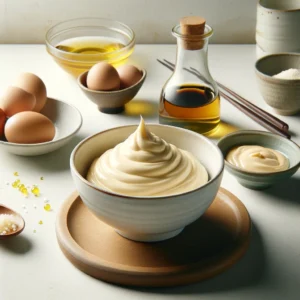Korean mayo has become a rising star in the condiment world. This popular sauce adds a tangy, creamy kick to any dish it touches. For those unfamiliar with it, Korean mayo might seem like just another mayonnaise. But there’s much more to this condiment than meets the eye.
In this article, we’ll explore everything there is to know about Korean mayo. We’ll look at what makes it different from other mayos, trace its origins, and break down the key ingredients that give it its distinctive flavor. You’ll also learn how to make authentic Korean mayo at home, and find out how it stacks up against similar condiments like Japanese mayo and Sriracha mayo.
By the end of this article, you’ll be an expert on all things Korean mayo. You’ll understand why it’s growing so rapidly in popularity across the globe. And you’ll have plenty of recipe ideas for incorporating this versatile condiment into your own cooking. So whether you’re already a fan of Korean food or simply looking to expand your condiment horizons, read on to become a Korean mayonnaise convert!
Korean Mayo: What is it?
Korean mayo is a variety of mayonnaise that originated in South Korea. It has a sweet, tangy flavor that comes from the addition of ingredients like apple cider vinegar, lemon juice, and sugar. The most iconic brand of Korean mayo is called Ottogi.
Compared to regular American-style mayonnaise, Korean mayo tends to be thinner in texture and less eggy in flavor. It strikes a delicious balance between rich creaminess and bright, acidic tanginess. This versatile condiment can liven up everything from fried chicken to potato salad.
History of Korean Mayo
While mayonnaise has roots going back hundreds of years in Europe, Korean mayo as we know it today traces back to the 1970s. Food manufacturer Ottogi pioneered mass production of the condiment to meet changing tastes in South Korea. As the country modernized and Westernized, the market grew for localized adaptations of foreign foods like mayonnaise.
Ottogi introduced their mayo to appeal to Korean preferences for lighter, fresher flavors compared to regular mayo. Over the next few decades, Korean mayo exploded in popularity across the country. Today, it’s found in restaurants and homes nationwide as an essential condiment.
Ingredients of Korean Mayo
The key ingredients that set Korean mayonnaise apart include:
- Apple cider vinegar – Gives Korean mayo its tangy flavor
- Lemon juice – Provides brightness and acidity
- Sugar – Balances the acidity with subtle sweetness
- Vegetable oil – Thinner than other mayos for a lighter texture
- Gochujang – Some recipes add this spicy Korean chili paste
By tweaking the proportions of these ingredients, you can customize the exact flavor profile you want. The vinegars, lemon, and sugar create the base tangy-sweet taste, while the oils lend a smooth, creamy texture.
How to Make Korean Mayo?
Making homemade Korean mayo is simple. Here are the basic steps:
- Whisk together egg yolks, vinegar, lemon juice, salt, and sugar.
- Slowly drizzle in vegetable oil while continually whisking.
- Once emulsified, whisk in water to thin out the mayo.
- Add any other flavorings like gochujang, garlic, or herbs.
- Refrigerate for at least an hour before using.
The key is adding the oil slowly to emulsify the mayo. Keep whisking vigorously to prevent separation. Feel free to experiment with ingredients like Dijon mustard, sesame oil, or grated kimchi for your own unique flavor profile.
Korean Mayo vs. Japanese Mayo
Both Korean mayo and Japanese mayo have a tangy sweetness, but there are some differences. Japanese mayo, also called kewpie mayonnaise, uses more egg yolks and rice vinegar. This gives it a richer, eggy flavor and yellow color. Korean mayo relies more on lemon and fruit vinegars for a lighter tang. It’s also thinner in texture than the thicker, creamy kewpie style mayo.
Korean Mayo vs. Kewpie Mayo
Kewpie mayo is the famous Japanese brand of mayo. It has a very eggy, custard-like flavor thanks to an abundance of egg yolks in the recipe. The vinegar used is a mild rice vinegar, which lends a gentle tanginess. Korean mayonnaise gets more tang from fruit-based vinegars and lemon juice. It also uses more vegetable oil for a thinner consistency than kewpie’s thick, creamy texture.
Korean Mayo vs. Sriracha Mayo
Sriracha mayo has the chili garlic kick of sriracha hot sauce mixed with regular mayonnaise. Korean mayo gets its flavor from sweet rice vinegar, lemon, and sometimes a hint of chili paste like gochujang. The two share a tangy, mildly spicy taste profile, but Korean mayonnaise is lighter and sweeter compared to the thicker, hotter sriracha version.
Uses for Korean Mayo
Beyond sandwiches and salads, try these tasty ways to use Korean mayo:
- Drizzle on fried chicken, fries, or tofu
- Mix into bibimbap or vegetable sautés
- Use as a dip for sweet potato fries or chunks
- Swirl into soups for added richness
- Spread on burgers in place of ketchup
With its bright, tangy flavor, Korean mayonnaise can liven up anything from grilled meats to fresh summer rolls. Experiment with creative new ways to incorporate this versatile condiment into meals.
Conclusion
For a condiment that adds creamy richness with addictive sweet-tangy flavor to any dish, look no further than Korean mayo. Now that you know all about its origins, ingredients, and uses, you can start whipping up your own recipes at home. Expand your condiment horizons and become a Korean mayo convert today!
FAQs
How do I make Korean mayo?
Making homemade Korean mayo is easy! Just whisk together egg yolks, vinegar, lemon juice, salt, and sugar. Then slowly drizzle in vegetable oil while continually whisking to emulsify. Once thickened, add water to thin out the mayonnaise to the desired consistency. You can also add other flavorings like gochujang paste, garlic, or herbs.
What are some recipes that include Korean mayo?
Some tasty recipes to try with Korean mayo include: – Korean mayo pasta salad – Bulgogi burgers with Korean mayo – Korean-style potato salad – Bibimbap with Korean mayo – Fried chicken drizzled with Korean mayo – Korean mayonnaise and sriracha dipping sauce
What products contain Korean mayo?
Popular brands of Korean mayo include Ottogi, Kewpie “Mayonnaise Dressing”, Mama Sita’s, and Sir Kensington’s. Many mainstream mayo brands like Hellmann’s are also now offering Korean mayo flavors to meet rising demand.
Where can I buy Korean mayo?
Look for Korean mayo at Asian grocery stores, larger supermarkets with international aisles, and online retailers like Amazon and Walmart. For maximum freshness, make your own by following an easy homemade Korean mayonnaise recipe.





1 Comment
Pingback: Delicious and Easy Korean Mayo Recipe for Any Meal